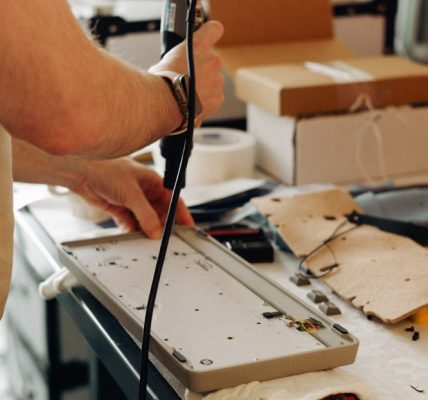The Artemis Lunar Mission: Odysseus, Troy Henderson, and the Intuitive Machines Moon Sculptors
This is the first privately owned craft to accomplish its goal since the Astrobotic lander failed to reach the Moon.
Odysseus is expected to operate for 14 Earth days, after which Intuitive Machines anticipates that the incoming lunar night — a period of prolonged cold that the lander isn’t designed to withstand — will force it to shut down. Additional payloads from other, private customers aboard the lander include an “EagleCam” CubeSat camera system built by students at Embry-Riddle Aeronautical University in Daytona Beach, Florida, and an art project by Jeff Koons containing 125 miniature Moon sculptures.
Odysseus was on his journey to the Moon and took several pictures, including one of the Earth. One image taken by the lander’s Terrain Relative Navigation camera shows the Moon from approximately 100,000 kilometers (around 62,137 miles), later followed by a close-up shot of the Bel’kovich K crater.
A radio navigation beacon and laser retroreflector array are used to help other craft make precision landings and provide data to astronauts.
Since December 1972, when NASA ended its famed moon-landing program, the U.S. had not landed on the moon. NASA’s new effort to return astronauts to the moon is named Artemis after Apollo’s mythological twin sister. The first Artemis crew landing is expected to take place in the year 2026.
Intuitive Machines anticipates just another week of operations on the moon for the solar-powered lander — nine or 10 days at most — before lunar nightfall hits.
Troy Henderson said that his team will attempt to release Eagle cam in the next few days in order to take a picture of the lander.
An experiment was supposed to have a cube with four cameras pop off 30 seconds before Odysseus lands. The navigation switch kept the EagleCAM attached to the lander, so it was powered off during the final descent.
Odysseus offered up some nail-biting moments in the hours before landing, such as the malfunction of the laser rangefinders that were supposed to help guide its autonomous journey down to the lunar surface. Mission engineers had to upload a software patch to jury-rig it to use a secondary laser provided by NASA instead.
One of the NASA experiments was pressed into service when the lander’s navigation system did not kick in. The problem was caught in advance when Intuitive Machines tried to use its lasers. Otherwise, flight controllers would not have discovered the failure until it was too late, just five minutes before touchdown.
The Malapert A Crater: On-board Operations of the Odysseus Mission to Land at the Moon’s South Pole
NASA’s experiments were on board of Odysseus’ mission. NASA paid $118 million for the delivery under a program meant to jump-start the lunar economy.
Regardless of how operational the spacecraft might be going forward, the landing is a major shot in the arm for US and commercial efforts to return to the Moon. The private mission was paid for by NASA and the space agency is counting on companies like Intuitive Machines to help ferry equipment to the Moon in preparation for sending astronauts to the lunar surface.
The Malapert A crater is 300 kilometres from the lunar south pole. The dirt and shadowy craters of the Moon’s south pole may contain ice which could provide future lunar explorers with fuel and other resources. Most of the lunar landers have been to the central regions of the Moon, but the only mission that has landed at the south pole is India.
Altemus said flight controllers’ ability to get data down was limited by some antennas pointing toward the surface. The antennas were stationed high on the 14-foot (4.3-meter) lander to facilitate communications at the hilly, cratered and shadowed south polar region.
An Intuitive Machine’s View of Odysseus: News from the Return of the U.S. Lunar Landers
Before Thursday’s touchdown, Intuitive Machines believed Odysseus was upright. Steve Altemus said Friday the craft probably leaned against a rock after catching a foot in the surface. He said it was coming in too fast and may have snapped a leg.
The private U.S. lunar landers made a crash landing at the moon’s south pole, which made it difficult to communicate, officials said Friday.
The exact state of the spacecraft remained unclear immediately after its landing, which occurred at 5:23 p.m. Houston time. It was sending a faint signal back to mission control in Houston, telling them that some parts of it had survived the touchdown. The control room burst into cheers after the mission director said, “Odysseus has found its new home.”
The US has returned to the moon, according to NASA administrator Bill Nelson. Today is a chance to see how NASA’s commercial partnerships work.
The first images from the lunar surface are expected within a few hours of the landing, depending on how communications with the spacecraft go. If Odysseus’s scientific payloads check out successfully, they could collect data for up to seven days, until night falls at the landing site and there is no more solar power left for operations.
Fate of an Astrobotic Mission to Land on the Moon: The Case of Odysseus, a Spaceship with Methane Fuel
Five of the last nine Moon landing attempts have failed. A mission launched last month by Astrobotic in Pittsburgh, Pennsylvania, ran out of fuel within hours of its launch due to a valve malfunction. In January, the Japanese space agency succeeded in putting a lander near the Moon’s equator, but it landed upside down.
After firing its engines, the spaceship moved into a series of maneouvres, in which it began looking at craters and boulders beneath. It navigated towards its intended landing site and fired its engines again to slow its descent, ultimately touching down on the surface.
The craft Odysseus is the first in space to burn rocket fuel. Methane-based propellants can be used in rocket engines, which means they are less harmful to the environment. They need to remain at ultra- cold temperatures to be difficult to work with. Methane is becoming increasingly popular in the future, as other companies plan to use it.




